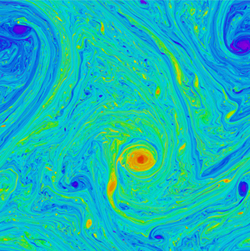2d-3d energy exchanges in a homogeneous thin-aspect-ratio ocean
Duration: 33 mins 20 secs
Share this media item:
Embed this media item:
Embed this media item:
About this item

| Description: |
Straub, D (McGill)
Friday 12 December 2008, 12:00-12:30 Rotating Stratified Turbulence and Turbulence in the Atmosphere and Oceans |
|---|
| Created: | 2009-01-16 11:12 | ||||
|---|---|---|---|---|---|
| Collection: | The Nature of High Reynolds Number Turbulence | ||||
| Publisher: | Isaac Newton Institute | ||||
| Copyright: | Straub, D | ||||
| Language: | eng (English) | ||||
| Credits: |
|
||||
| Abstract: | Because of its thin aspect ratio, large scale ocean circulation is generally assumed to obey hydrostatic dynamics. In the idealized case of a homogeneous (unstratified) fluid, this implies that the horizontal pressure gradient force is independent of depth. Homogeneous models of ocean circulation typically assume the flow to be two dimensional. However, it can be shown that such a two dimensional flow is unstable to 3d perturbations. Following saturation of the 3d perturbations, a 2d-to-3d energy transfer persists. After a brief description of the instability mechanism, we i) test its robustness to nonhydrostatic effects and ii) address its potential role in the damping of midlatitude ocean gyres. Initially 2d turbulence in a Boussinesq fluid is shown numerically to be unstable to 3d perturbations. Although non-hydrostatic pressure effects act to slow the growth, a robust growth in nonetheless observed even at unit aspect ratio. The perturbations are found to saturate at a level proportional to the domain aspect ratio. Thus, in the thin aspect ratio limit, nearly 2d dynamics are recovered --- provided the 3d modes are not externally forced. We then consider the classic wind-driven ocean gyre problem for a homogeneous thin aspect ratio fluid on a beta plane. A large-scale stochastic forcing is applied to the 3d modes. This produces a background sea of near-inertial oscillations which interact with the depth averaged flow. It is found that 2d-to-3d energy transfers coupled with a forward cascade of 3d energy provides a robust dissipation mechanism for the gyres. We speculate that similar dynamics may also apply in a stratified ocean.
A seminar from the Rotating Stratified Turbulence and Turbulence in the Atmosphere and Oceans conference in association with the Newton Institute programme: The Nature of High Reynolds Number Turbulence www.newton.ac.uk/programmes/HRT/seminars/ |
|---|---|
Available Formats
| Format | Quality | Bitrate | Size | |||
|---|---|---|---|---|---|---|
| MPEG-4 Video | 480x360 | 1.83 Mbits/sec | 459.09 MB | View | Download | |
| WebM | 450x360 | 634.87 kbits/sec | 154.38 MB | View | Download | |
| Flash Video | 480x360 | 802.21 kbits/sec | 196.44 MB | View | Download | |
| iPod Video | 480x360 | 503.06 kbits/sec | 123.19 MB | View | Download | |
| QuickTime | 384x288 | 844.03 kbits/sec | 206.68 MB | View | Download | |
| MP3 | 44100 Hz | 125.0 kbits/sec | 30.26 MB | Listen | Download | |
| Windows Media Video | 475.34 kbits/sec | 116.40 MB | View | Download | ||
| Auto * | (Allows browser to choose a format it supports) | |||||

